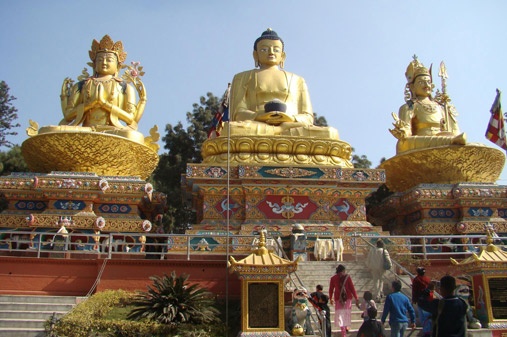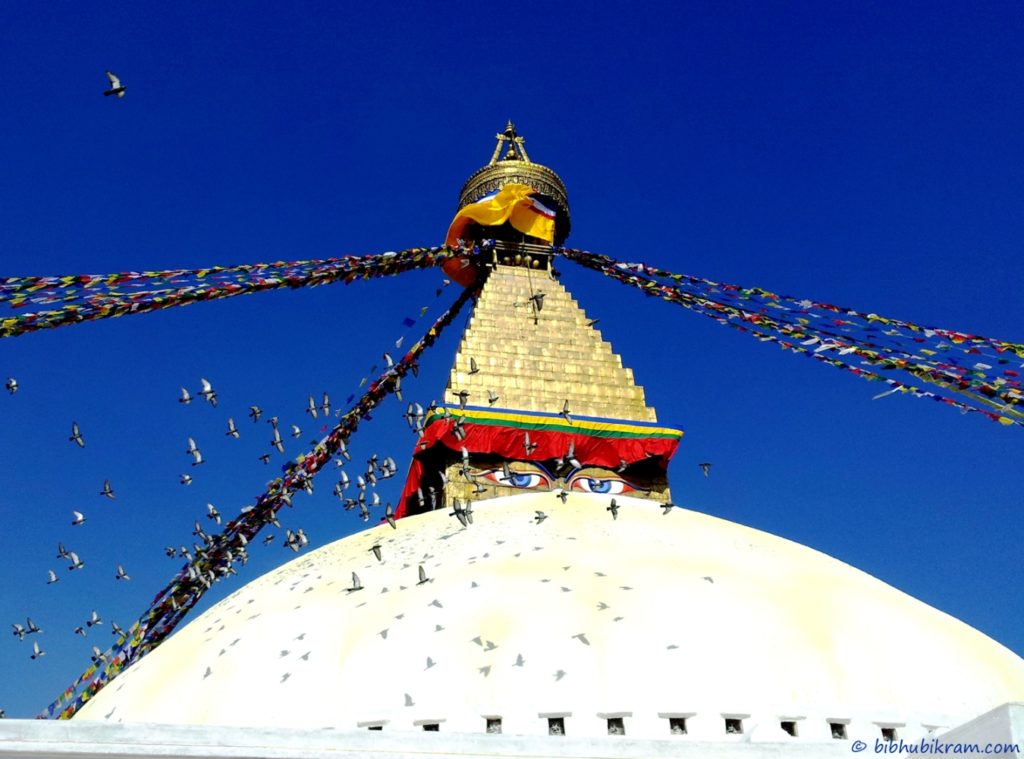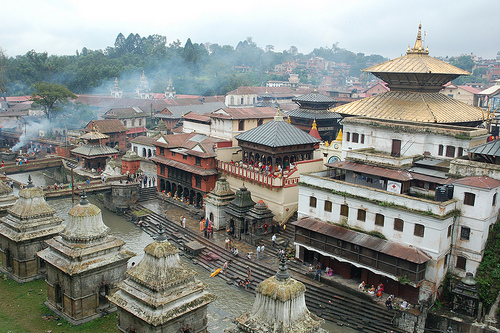Kathmandu is not only the capitol of Nepal but also the main gateway for many of the international visitors who arrive every year. With a history dating back over two thousand years it has survived well by integrating the 20th century into its glorious past where modern day buildings live side by side with the many temples of yesterday. This 4 day tour package covers the entire major city in Kathmandu Valley like Kathmandu, Bhaktapur, and Patan. And will cover all of the major religious & historical sites in the valley that have played a part in shaping the history of Nepal. This package includes several UNESCO world heritage sites located in Nepal. It starts from Kathmandu, Bhaktapur, Patan Durbar Square and Swoyambhunath. Pashupatinath & Boudha with the famous temple located near to the hill station like place Nagarkot.

Day 01 Arrival in Kathmandu
On arriving at the Kathmandu international airport you will be greeted by one of our representatives who will welcome you and assist in your transfer to a hotel. They will be available for any questions along the way and will make sure you have the chance to refresh before you tour starts in the morning.

Day 02/03 Sightseeing Full day city tour
Because there is so many places to see its actually hard to have a cast iron schedule so please keep an open mind on this. But after breakfast you will be met by a professional license holder tour guide with private vehicle and set off to one of the following places.
Pashupatinath Temple:
One of the most sacred Hindu shrines in the world the temple lies 5 km east from the city centre. The temple consists of richly-ornamented pagoda houses, sacred lingam, or phallic symbol, of Lord Shiva as well as the noteworthy gold plated roofs and silver coated doors. Being one of the holiest of all of Lord Shiva shrines it’s a visiting place for many religious pilgrims and
Sadhus who travel all the way from the remote areas of India to visit this sacred sight, especially during Shivaratri (the night of Shiva) that falls between February/March. Even though these devotees have denounced worldly possessions, each carries a Sadhus ID (identifications card) to freely cross over the border between India and Nepal. Looking back in the historical Chronicles Pashupatinath existence dates prior to 400 AD and since this time devotees have been taking ritual dips in the holy Baghmati River flowing beside the temple, also a World Heritage Site. The crematorium is just outside the temple and it is a dream of almost every Hindu to be cremated by the side of Pashupati Aryaghat after their death.
Bouddhanath Stupa:
The Stupa lies around 6 km east of downtown Kathmandu and is the largest stupa in the Valley and one of the largest in the world. Looming 36 meters high it presents one of the most fascinating specimens of stupa design with hundreds of prayer wheels and 108 small images of Buddha all around in structure. Just like the Swoyambhunath, the stupa here is too has four sides with the watchful eyes of Lord Buddha. In times of religious festivals you will find the whole area crowded with Buddhist’s.
Kapan Monastery:
Is one of the most famous of all monasteries built by the monks following the Gelug tradition of Tibetan Mahayana Buddhism under the guidance of Lama Zopa Rinpoche. Set high in the hills above the Kathmandu valley it takes up to an hour to reach by car. The air is clean and the view across the valley is magic. Kapan was established by Lama Thubten Yeshe and Lama Zopa Rinpoche in 1970 as a centre of Buddhist learning in response to a strong wish expressed by their Western students for spiritual guidance and for a place to study.
Swoyambhunath Stupa:
Swayambhu literally means ‘Self-Existent One` and was believed to have been established more than 2,500 years ago. Legend has it that Swayambhu was born out of a lotus flower that bloomed in the middle of the lake which the Kathmandu valley once was. But translations from an inscription dating back to 460 A.D states it was built by King Mandeva and has existed ever since growing in importance for Buddhists from all over the world. And by the 13th century, Swoyambhunath had developed into an important centre of Buddhism. The largest image of the Sakyamuni Buddha in Nepal was recently built on the western boundary of Swayambhu. And behind the hilltop is a temple dedicated to Manjusri or Saraswoti – the Goddess of learning. Chaityas, statues and shrines of Buddhist and Hindu deities fill the stupa complex. The base of the hill is almost entirely surrounded by prayer wheels that were recently installed and devotees can be seen circumambulation the stupa at all times. The stupa sits atop the hill and the exceedingly steep stone steps leading up to the shrine is quite a challenge. However there is also a road going up almost to the top and you can drive up. A large numbers of Buddhists and Hindus alike visit Swoyambhunath throughout the day.
Kathmandu Durbar Square:
Deep in the heart of old Kathmandu city in Basantapur is the Kathmandu Durbar square and it never fails to impress first time visitors with its intricate wood carvings and rich history. Surrounded by modern day concrete buildings, the complex is an oasis in a fast developing, chaotic modern city. Once the residence of Nepal Royal family, all coronation ceremonies were held here it’s now become a major tourist attraction. The palace is an amalgamation of eastern and western architecture with additions by Rana and Shah Rulers over the centuries. And now has an unbelievable 50 temples within the vicinity including the temple of the titular deity Tajeju Bhawani. The Durbar is divided into two courtyards, the outer Kasthamandap, Kumari Ghar, and Shiva-Parvati Temple, and the inner section consisting of Hanuman Dhoka and the main palace. Some floors have been converted to museums dedicated to three generations of Shah Kings. Most parts of the palace premises are open to tourists throughout the week.
Patan Durbar Square:
Patan Durbar Square complex is perhaps the most photographed of the three durbar squares. And is located in the heart of Patan city where the kings of Patan once lived and ruled their subjects. The square is a display of Newari architecture that had reached its pinnacle during the reign of Malla kings who were great builders and patrons of the arts. The palace has three main courtyards: the central and the oldest is Mul Chowk, to the west of the complex are a dozen free standing temples of various sizes and built in different styles. A masterpiece in stone, the Krishna Temple, Bhimsen Temple, the Golden Temple of Hiranya Varna Mahavira and Sundari Chowk mark the artistic brilliance of the Newar craftsmen of that era. The Sundari Chowk with the sunken bath of Tusha Hiti showcases exquisite woodcarvings, stone and metal sculpture. Like the other palaces, Patan Durbar Square also houses a temple dedicated to Taleju Bhawani. At the end of the first day you return back to hotel and after your refreshment we will talk about next day’s tour/ sightseeing information and overnight in hotel.
Day 04/05 Sightseeing in Nagarkot-Changunarayan-Bhaktapur
Early in the morning we will drive you in Nagarkot by car to see the sunrise view of Himalayan ranges with snow cover to near to you. Because it’s one of the best places to see the sunrise close to the KTM valley as well as having a glimpse of rural culture in the time you have left in Nepal. From here you can see the Manaslu Himalayan ranges, Ganesh Himal, Langtang Himalayan range, Rolwaling Himalayan range and far-east Everest ranges. After breakfast in Nagarkot you will drive to Telkot and hike up to Changunarayan temple.

Changunarayan Temple:
Perched on a hill and visible from miles around, the Changu Narayan temple stands majestically above the rice fields of Bhaktapur. Dedicated to Vishnu, the Preserver the temple’s origins go back to the 4th century. A fifth century stone inscription in the temple proclaims it as one of the oldest shrines of the Kathmandu Valley. The temple is a showcase for Newari art and architecture of the early century. The stone, wood, and metal craft found here are exemplary. On the struts of the two-tiered Changu Narayan Temple, are ten incarnations of Narayan. And a 6th Century stone statue shows the cosmic form of Vishnu. Garuda, half man and half bird, is the vehicle of Vishnu, and his life-size statue kneels before the temple.
Bhaktapur Durbar Squire:
At the centre of Bhaktapur city is the least busy of the Durbar squares in the valley. The architecture dates back to the Malla period and the setting is made more charming, with wide open spaces that are off limits to vehicular traffic. Here you see some of the finest medieval arts of Nepal including the Golden Gate, Fifty-five Windows and the beautiful statue of King Bhupatindra Malla mounted on a giant stone pillar. The Golden Gate was erected by King Ranjit Malla as the entrance to the main courtyard of the Fifty-five Window Palace. The Palace of Fifty-five Windows was built during the reign of King Yakshya Malla in 1427 A.D. and was re-modelled by King Bhupatindra Malla in the 17th Century. The Art Gallery has a fascinating collection of ancient manuscripts, Thangkas, centuries-old stone sculpture, antique paintings that belong to the Hindu and Buddhist traditions of various periods. This gallery is open every day of the week except Tuesday. Then after we will drive to Kathmandu if we have time we will visit Narayanhiti Palace Museum where in 2001 AD.
Day 06 Back to your own Destination
We will be happy to assit you in any way whether its more experiences of Nepal or the flight back home.
